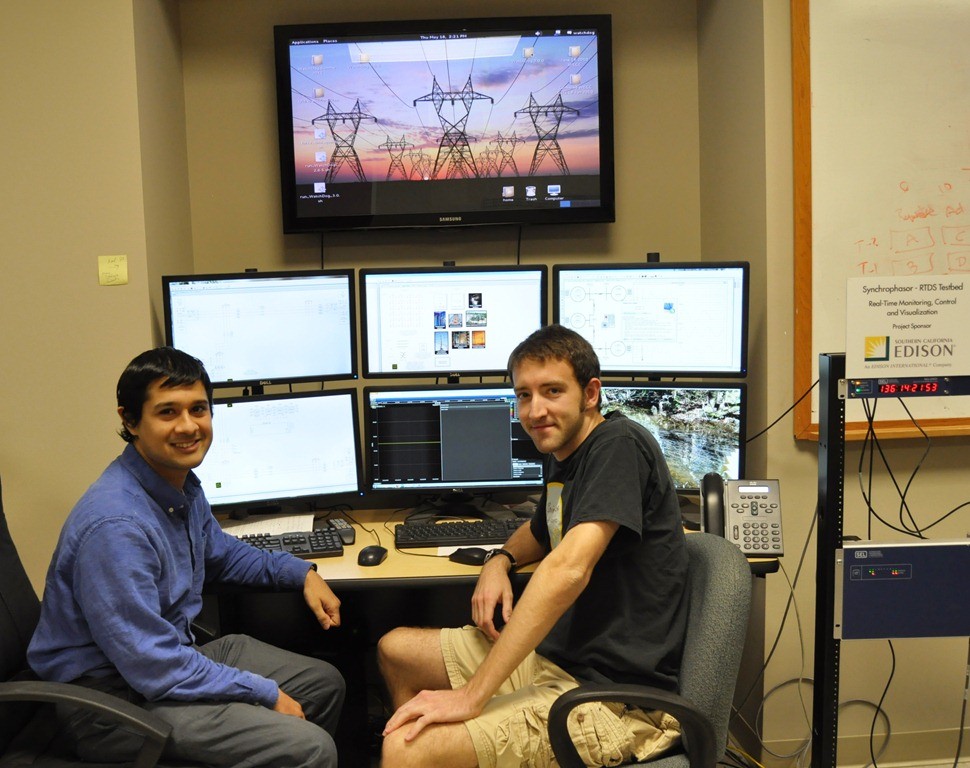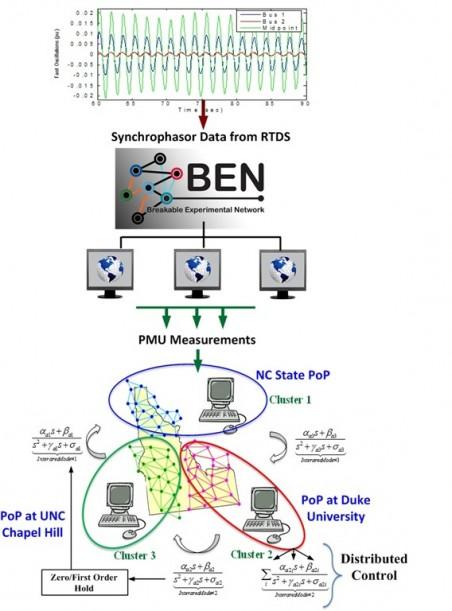
Chakrabortty Receives Award for Research for Development of a Multi-User Network Testbed
Dr. Aranya Chakrabortty (L) with one of his students NC State University has received a $200K research grant from the US Department of Energy to advance its ongoing research and education in wide-area monitoring and control of power systems using Synch …
June 28, 2013 ![]() NC State ECE
NC State ECE
NC State University has received a $200K research grant from the US Department of Energy to advance its ongoing research and education in wide-area monitoring and control of power systems using Synchronized Phasor Measurements (or “Synchrophasors”). Synchrophasors are high-resolution measurements of the currents and voltages of large power systems that capture detailed oscillations of the power flows in different parts of the grid — particularly useful to analyze critical disturbances such as a blackout. The devices that measure Synchrophasors are called Phasor Measurement Units (PMU). In this project, NC State researchers will use Synchrophasor data — provided by our local utility company Duke Energy as well as a long-standing collaborator, Southern California Edison — to create reliable power system models by which critical disturbances such as blackouts can be predicted and controlled.
The two-year project is headed by Dr. Aranya Chakrabortty, Assistant Professor in Electrical & Computer Engineering, together with co-investigators Dr. Mesut Baran, Professor of Electrical and Computer Engineering, and Dr. Pam Carpenter, MS-EPSE Education Program Manager.
Over the past one year, Chakrabortty and his research group have developed a hardware-in-loop laboratory infrastructure using multiple PMUs integrated with a Real-time Digital Simulator (RTDS), housed at the FREEDM Systems Center. The RTDS is a supercomputer that can simulate large and complicated power system models in almost real-time. This facility will now be extended to create a multi-port, multi-user, and multi-vendor network of PMUs spread across the three campuses of NC State, Duke University and UNC Chapel Hill through an existing metro-scale fiber optic communication network called the Breakable Experimental Network (BEN), hosted by the Renaissance Computing Institute (RENCI). This PMU network will allow multiple users at various points of the network to process and communicate PMU data between each other, and collaboratively use them for critical applications such as power oscillation monitoring, distributed state estimation and, most importantly, distributed control. For example, local users in this PMU network may access artificial PMU data generated by RTDS simulations in real-time, run their individual local algorithms using these data, and then communicate the results to neighboring users until the control-loop reaches a global consensus over time. The project will also study the sensitivity of these distributed control algorithms on network latencies, data loss, and malicious attacks by hackers. Chakrabortty and his team will collaborate with local utility company Duke Energy as well as with longstanding collaborator Southern California Edison, ABB, and RENCI to realize this network testbed.
The Renaissance Computing Institute at North Carolina State University opened in early 2007 and supports the use of visualization technology and analytical methods to explore engineering, scientific, design and educational challenges. The site focuses primarily on serving the NCSU community, its partners and collaborators.
The Future Renewable Electric Energy Delivery and Management (FREEDM) Systems Center, headquartered on NC State University’s Centennial Campus, is one of the latest Gen-III Engineering Research Center (ERC) established by National Science Foundation in 2008. The FREEDM Systems Center will partner with universities, industry and national laboratories in 28 states and nine countries to develop technology to revolutionize the nation’s power grid and speed renewable electric-energy technologies into every home and business.





